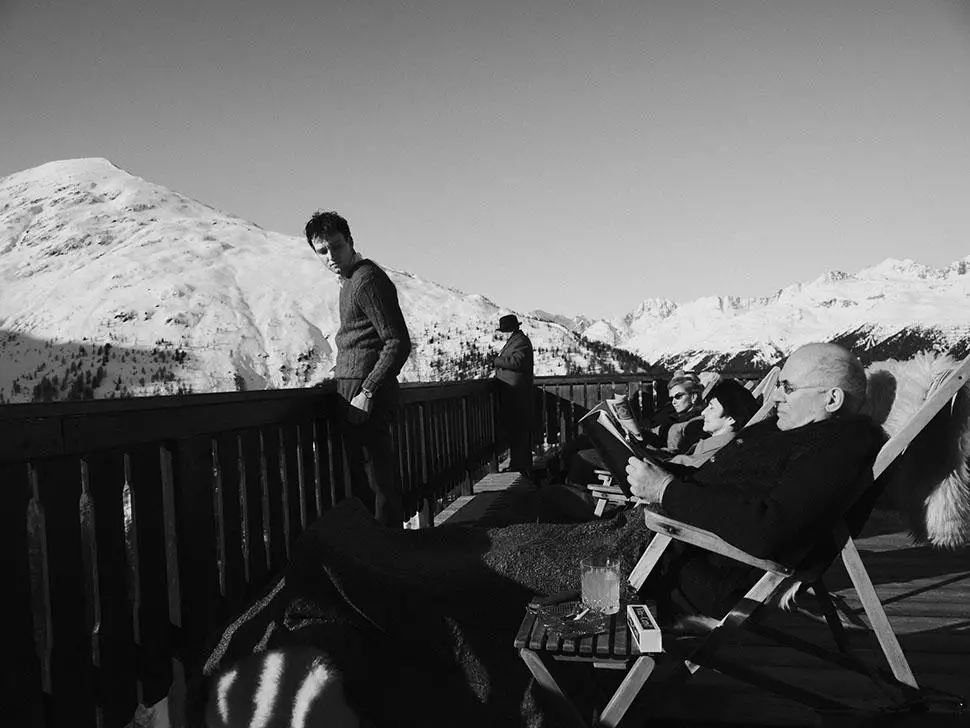Science fiction has long entertained us with the theory of the multiverse, where parallel worlds branch out from every possible choice and decision, populated with alternate versions of ourselves. Director Timm Kröger takes this theory, which has fascinated us since the 1950s, and delves deeper into its mysterious and sinister nature in his film, “The Theory of Everything” (Die Theorie von Allem).
Set amidst the silent whiteness of the Swiss Alps in winter, the film immediately transports us to another world. Johannes Leinert, a young scholar played by Jan Bülow, finds himself studying under the severe Dr. Julius Strathen (Hanns Zischler). Despite his supervisor’s disdain for Johannes’ metaphysical theory, the young scholar finds solace in the company of Dr. Strathen’s old academic rival, Professor Blumberg (Gottfried Breitfuss), and the alluring hotel pianist, Karin Honig (Olivia Ross).
A Web of Mystery and Suspicion
As Johannes and his companions attend a physics conference in Switzerland, a series of peculiar events unfolds. Professor Blumberg is found dead in the snow, triggering an investigation by two enigmatic detectives. The conference is plagued by suspicious deaths, unexplained phenomena, and the emergence of sinister tunnels rumored to hide evil activities beneath the mountains.
Meanwhile, Johannes grapples with a recurring dream of being trapped in a bomb shelter with his mother. This dream’s significance becomes clear when he discovers the secret experiments being conducted under the mountains. Here, hatchet-faced men push the boundaries of time, causing explosions that fracture the fabric of reality. Karin appears intermittently amidst the chaos, leaving Johannes questioning her true nature and intentions.
“The Theory of Everything” immerses viewers in the world of quantum physics through references to influential figures such as Niels Bohr and Werner Heisenberg. Johannes is surrounded by equations and calculations, and while Kroger ensures their authenticity, the film doesn’t overwhelm viewers with complex scientific concepts meant to showcase the characters’ intelligence. Instead, it emphasizes the metaphorical potential of parallel worlds and their existence.
A Cinematic Collage of Styles
Kröger’s directorial style creates a visual multiverse, blending elements of various cinematic movements throughout history. The film’s texture evokes a fusion of “The Magic Mountain,” Erich Kästner, Hitchcock, and Tarkovsky. At the same time, it echoes the French Nouvelle Vague, film noir’s jagged camera angles and contrasting light and shadow, and the German skiing films romanticizing adventure in the open air. The cinematography occasionally zooms out to reveal sweeping mountain landscapes reminiscent of nostalgic alpine postcards.
The film also employs long tracking shots reminiscent of ’50s studio films, punctuated by sudden bursts of abstract visuals reminiscent of ’60s psychedelia. This pastiche of styles creates a captivating visual symphony, where disparate pictorial histories play out simultaneously, reflecting the tumultuous events of the last century.
Complementing the rich visual tapestry is a score by Diego Ramos Rodriguez. The music, loud and lush, surges alongside the story, amplifying the melodrama. It pays homage to classical film music while adding a contemporary flair. Yet, its overwhelming presence may prove tiresome to some viewers, especially when coupled with the film’s elliptical storytelling and stylistic extremes.
A World of Infinite Chaos
In its exploration of the fears that underpin the 20th century, “The Theory of Everything” draws inspiration from German Expressionism, foreshadowing the horrors yet to come. As a film that delves into the unknown, it presents a self-contained universe that may not resonate with everyone. Some might prefer the familiar comfort of a Marvel movie, while others are intrigued by the elusiveness and complexity of “The Theory of Everything.” After all, within this marvelous multiverse, both can coexist.
Timm Kröger’s “The Theory of Everything” takes us on a captivating journey into the terrifying unknown of the multiverse. Set against the stunning backdrop of the Swiss Alps, the film intertwines elements of mystery, suspense, and quantum physics to create a unique cinematic experience. With its fusion of visual styles and a powerful musical score, it immerses viewers in a world where the boundaries of reality are pushed to their limits. However, its elliptical storytelling and overwhelming audio may prove divisive among audiences. Ultimately, “The Theory of Everything” offers a mesmerizing exploration of infinite chaos and the mysterious worlds that lie beyond our own.

